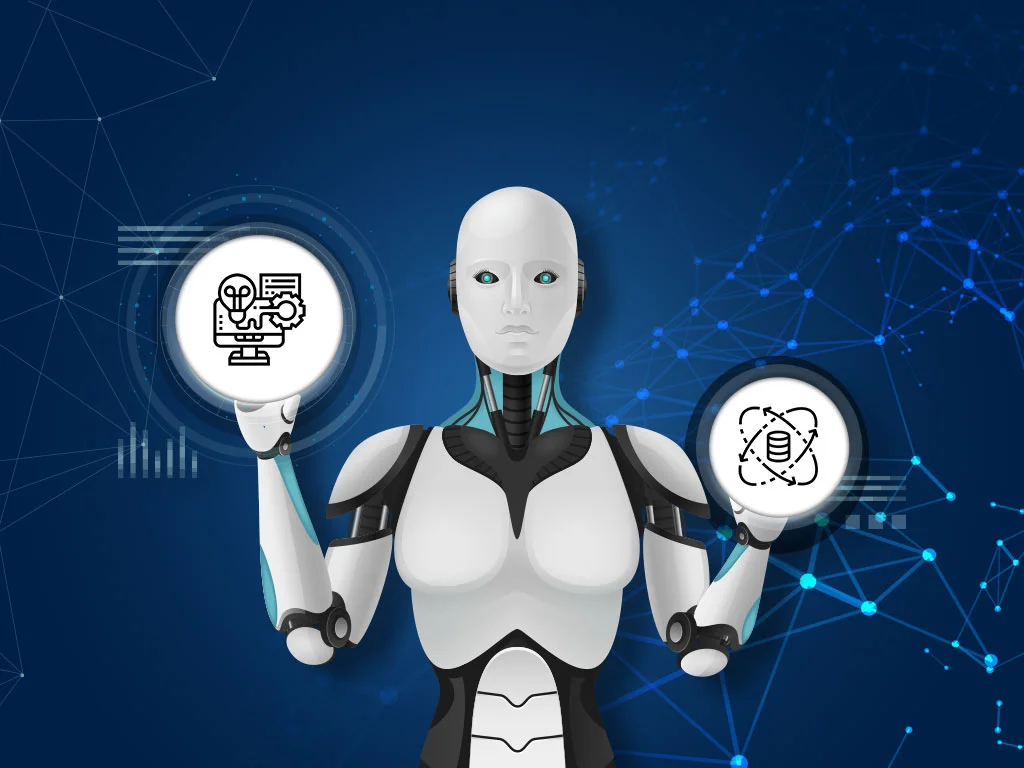Data science and machine learning future of sales & marketing
Data Science vs Machine Learning. Which of the two is more effective for sales marketing? Here, we compare the two terms to help you decide.

Today’s world is increasingly reliant on data. Every year, the amount of data we produce increases tremendously. Every day, at least 2.5 quintillion bytes of data are generated—that number with 18 zeros, in case you didn’t know. A lot of valuable information, crucial for various fields, can be comprehended from this data on how to improve outcomes in a shorter length of time. Whether it’s optimizing processes or making informed decisions, the significance of harnessing this data is undeniable. Enrolling in a Data Scientist Course, professionals equipped with the skills to analyze and derive insights from such vast datasets are in high demand. This course can be a strategic step towards mastering the techniques essential for navigating and interpreting this data-rich landscape.
What is Data Science?
As the name says, Data Science is all about data. As a result, we can define it as “An area of the thorough study of data, including extracting relevant insights from the data, and processing that information using various tools, statistical models, and Machine learning algorithms.” Data preparation, cleansing, analysis, and visualization are all included in this big data management paradigm.
Data scientists gather raw data from a variety of sources, prepare and pre process the data, and then apply machine learning algorithms and predictive analysis to glean actionable insights from the data they have gathered.
What is Machine Learning?
Artificial intelligence and the discipline of data science both include machine learning. Developing technology makes it possible for machines to automatically complete a task and learn from previous data. It is defined as:
Computers may learn from their prior experiences on their own thanks to machine learning, which uses statistical techniques to enhance performance and forecast results without explicit programming.
Email spam filtering, product suggestions, online fraud detection, etc. are some of the common uses of ML.
What is the difference between Data Science and Machine learning?
Where is Machine learning used in Data Science?
The development process or life cycle of data science can be used to understand how machine learning used in that field. The following are the several phases of the data science lifecycle:
Business Requirements
We attempt to comprehend the demand for the business challenge we intend to employ it for in this step. Consider a scenario in which we want to develop a recommendation system for the company’s objective to boost sales.
Data gathering
To address the issue at hand, data gathering is done in this step. We may obtain user ratings for various products, comments, purchase histories, etc. for the recommendation system.
Data processing
The process of converting raw data from the previous phase into a format that can be used by the following processes with ease.
Exploration of Data
In this step, we strive to comprehend the data’s patterns and draw valuable conclusions from them.
Modeling
Machine learning techniques are applied at the data modeling stage. Therefore, the entire machine-learning process is included in this step. Importing the data, cleaning the data, creating a model, refining the model, testing the model, and increasing the model’s effectiveness are all steps in the machine learning process.
Optimization & Implementation
The deployment of the model on the real project and evaluation of its success occurs in this final step.
How can Marketing profit from Data Science and Machine Learning?
| Data Science | Machine learning |
| Marketing Budget Optimization | Enhanced Audience Segmentation |
|
Budgetary restrictions are the main issue for marketers, for data might not match the plan, and effective budget consumption can be challenging.
By analyzing client purchasing patterns, a data science team can create a budget plan that will spend the budget more effectively. This will be helpful for many seasoned marketers to allocate their budget across various activities, channels, resources, and solutions to maximize crucial metrics.
|
Businesses can automate this process using machine learning algorithms for marketing, and can also uncover subtle trends in data that are invisible to the naked eye.
Moreover to be more effective, using an ML system to automatically choose the appropriate segmentation technique can increase conversion rates. When a company is more focused on reaching its target market, it may be far more persuasive and successful at turning a potential consumer into a regular customer.
|
| Determining constructive channels | Optimizing and Automating marketing campaigns |
|
The channels that provide sufficient revenue for marketers can be found using data science and machine learning. To examine, research, and identify the various lifts seen across numerous channels, a data scientist uses a time series technique.
Additionally, this can be advantageous since it demonstrates to the marketing team which channel or sign produces accurate and acceptable revenue.
|
Machine learning can be used to optimize and automate marketing campaigns, which can save time and money.
A/B testing can be used to test marketing strategies, but it is limited in scope. Machine learning can take into account more variables simultaneously and provide more accurate results. |
| Aligning consumer needs with Marketing strategies | Content generation |
|
To maximize the effectiveness of online marketing efforts on social media platforms, marketers must select the appropriate strategy. To achieve this, they can create a model for calculating a consumer’s lifetime value that can classify customers based on their presence.
For instance, firms could provide their best-value clients with discounts and even coupons for referrals while implementing retention methods for clients who are more inclined to leave their clientele.
|
A computer may be able to produce content automatically that resembles work done by a human thanks to machine learning. Generative adversarial networks, or GANs, for photos can be used to accomplish this. An adversarial network finds and removes undesirable outcomes, whereas a generative network creates content.
The project’s outcome will feature new visual content that can be used to improve marketing campaigns after numerous iterations. |
| SEO | Language processing and chatbot |
|
The method of increasing website traffic known as Search Engine Optimization (SEO) is rapidly changing thanks to data science. Data scientists acquire, examine, and provide comments on unprocessed data using search engine characteristics. In this SEO, a data science team wants to get rid of speculation.
Data scientists speculate on how things function and how a certain action affects the company’s goals in addition to predicting what is helping them to get the desired results and how they may maximize their achievement.
|
AI assistants are vital when considering machine learning’s applications in marketing.
Artificial intelligence (AI) assistants can act as online counselors, boosting the degree of client interaction with the company. AI assistants can perform a variety of activities, such as presenting order details, discount coupons, or the location of the closest store. Modern AI assistants are becoming more intelligent and capable of carrying out a variety of duties, giving the customer the impression that they are speaking with a real person. |
How can Sales profit from Data Science and Machine Learning?
| Data Science | Machine learning |
| Predicting Sales | Repetitive task automation |
|
Organizations place a great deal of weight on sales forecasting because it has a ripple effect on crucial company operations including inventory management, logistics, production, and labor planning. For instance, based on sales projections, raw material purchases and finished goods inventory management are profoundly influenced. Businesses may make smarter judgments and ensure that operations are functioning smoothly by accurately estimating sales.
In order to estimate sales with a high degree of accuracy, sales forecasting algorithms look for patterns and linkages among many aspects that influence sales under changing conditions.
|
High repetition workloads can be automated with the aid of machine learning. For instance, through a process known as Natural Language Processing, machine learning enables the automation of welcome emails to new leads, demo emails to new sign-ups, and follow-up emails to non-responsive emails (NLP).
Although voice recognition software is typically used to handle text-based queries and offer real-time responses, this technology can also be used to comprehend spoken phrases. Amazon’s Alexa and Apple’s Siri are excellent instances of speech recognition being used with automation; they allow for automated scheduling, answering, and data entering. |
| Enhanced Lead generation | Insight filtration |
|
Analytics has proven to be an excellent tool for streamlining and automating pre-sales procedures. Businesses are using a massive data pool to find the right customers at the right moment. Enterprises employ a wide range of historical data to obtain a comprehensive picture of their potential sales, and many businesses are pushing the envelope by implementing lead-scoring algorithms that are fueled by detailed and segmented information on each of their prospects.
Companies are noticing a considerable improvement in their capacity to discover attractive prospects and pinpoint the ideal time to approach them as a result of integrating intelligent automation into the insight creation process.
|
Advanced ML and AI systems are excellent at spotting trends. Typically, social media data consists of writings, photos, and other elements. We can use this data to identify the minute patterns and insights that can inspire new companies using computer vision (a technique where a computer analyses and analyses photos or videos) and natural language processing modules. With a continuously updated dataset, we can quickly filter out irrelevant data and discover what can open up new opportunities. |
| Analysis of consumer sentiments | Optimization of Sales |
|
Understanding consumer feedback is made easier with the use of sentiment analysis. It makes use of AI to understand both the semantics of the dialogue and the emotions expressed by the clients. Businesses can benefit from knowing how consumers view their brand.
Text mining algorithms are used in sentiment analysis to draw conclusions from social media, blogs, and review websites. Real-time actionable insights can be gleaned through automated sentiment analysis techniques.
|
This situation might benefit greatly from an ML-driven sales practice principle based on previous customer data and predictive analysis modeling. Depending on the customer type, there are some behaviors you should target and others you should avoid, such as contacting the customer every five minutes until they make a purchase. When sales manager understands the relationship between client behavior and their actions, they can better manage their team, achieve higher close rates, and boost productivity. This association can also be used to motivate individualized sales strategies for each individual customer.
|
| Cross and Upsale | Sales forecasting |
|
Companies can use data analytics to determine key sales criteria like key value items, key value categories, popular products, and high-demand products that can affect the sales bottom line and have an insight into how their upsell and cross-sell plans will function well in advance. Data science is also used to provide tailored cross-selling recommendations, which point out complementary goods that a customer might like to purchase in addition to a product they have already purchased or intend to purchase.
|
A centralized repository is made available with the development of Customer Relationship Management (CRM) technology and can be used for machine learning. One of the main goals of a CRM is demand forecasting. Sales projections can be easily automated and optimized for salespeople if they are incorporated into a CRM with updated and automated pipelines. Setting short-term goals can be aided by using the data-driven prediction as a baseline and as the typical level of company. Additionally, it can be used to develop budgets and plans. The sales team might boost its profit and balance supply and demand with a more precise prediction.
|
Final Thoughts
Modern sales professionals need data to be competitive, whether it’s to enhance customer experience, lower churn, or generate leads. Big data analytics usage is what sets winners apart from losers across businesses and functions.



